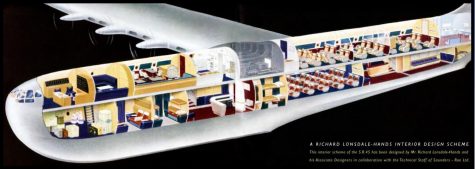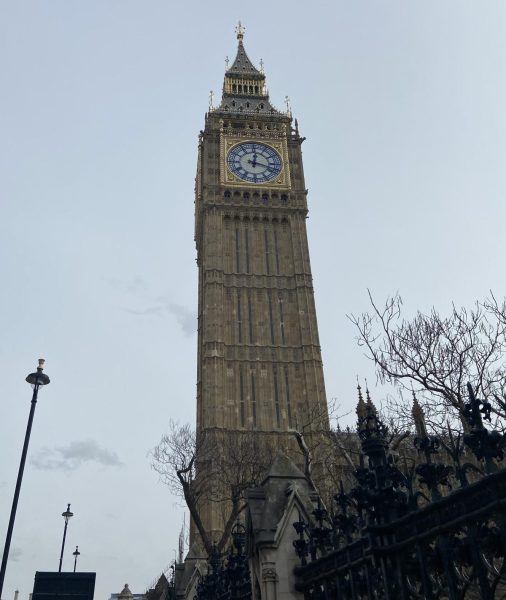A Cruise in the Sky
A Cruise in the Sky
In modern times, if someone asked you if you think it was possible to combine a cruise with a plane, you would probably say yes. But if you were to really think about it, how would it work? If you wanted to stop on an unpopulated island you would not be able to because there would be nowhere to land the plane. But what if I told you that there used to be a plane that could exactly that? It was designed to give each their own sleeping quarters, along with having a restaurant, lounge area, and so much more. Moreover, what if I told you that this plane actually existed, and existed in the 1950s, right after World War II?
Before World War II, the enterprise of civil aviation was limited not only to those with money but also to those near the few airports and runways around the world. As a result of this, there were two main types of planes: land-planes and sea-planes. Land-planes were limited on where they could fly since planes were still somewhat new to the world and were nowhere near as advanced as the planes we have today. Whether it was because of fuel capacity or just lack of power in the engines, planes could not go far distances. Sea-planes took the plane design and added floatation devices in different ways so that the plane could take off and land on bodies of water. Before World War II, sea-planes were ahead of land-planes because they put passengers at ease being over bodies of water in planes that wouldn’t sink so that if an accident occurred, the Coast Guard could rescue them.
After World War II, on the other hand, thousands of airports and runways were built around the world, opening a gateway to the planes we know today. The vast majority of runways and airports made during the war were converted to public spaces and runways, adding steam to the development of modern planes, but that did not stop the manufacturers of sea-planes to push forward in hopes of a different future. The Saunders-Roe SR.45 Princess was one of these sea-planes that were manufactured after the war in hopes of the growing future of sea-planes. The Princess was an odd-looking plane, to say the least, but it’s odd shape reduced drag and made the flight even more comfortable for passengers. The Princess had luxury written on it from top to bottom. Its two-floor cabin could carry 50 to 100 passengers, while also providing sleeping quarters, a bar and lounge, and even a restaurant. But if this plane was so luxurious and safe, why did it fail?

The Princess’s maiden flight took place on the 22nd of August 1952. Meanwhile, in the same year, the very first jet airliner was also released, The Comet. Some of the problems with flying boats were that they needed larger, stronger fuselages, so they were naturally heavier, less aerodynamic, and difficult to pressurize. On top of that, flying boats were also more difficult to fly and required pilots to receive additional training. The plane also needed more maintenance due to its exposure to the corrosive salt water. Because of all these factors, flying boats were less profitable for airlines. Airliners were already buying mass amounts of the new Comet jet planes, and as a result, the age of flying boats met its end. The only ever finished Saunders-Roe Princess was put into storage along with two unfinished models.
But Saunders-Roe’s engineers, though facing the end of flying boats, had one last opportunity to dream up the ultimate flying cruise. They came up with a sea-boat capable of carrying up to 1000 passengers, deciding not to fight with new jet airplanes, but instead compete with a different market, ocean liners. Ocean liners were still used by the masses during the 1950s, and as a result, Saunders-Roe decided to compete with their flying ocean liner. The plane itself was 318 feet long! With five decks and a crew of fifty people. In order to get the flying behemoth into the air, Saunders-Roe engineers envision twenty-four jet engines integrated into the enormous wings. The wings were to be so big that the crew could walk inside the wings to give maintenance mid-flight. Sadly though, this enormous flying boat never made it off the drawing board. This ended up being the last flying boat ever designed by Saunders-Roe. Instead, they started focusing on other emerging fields within the 1960s, such as hovercraft research. And soon Saunders-Roe as a company would disappear altogether, merging with other British aircraft companies.
The Princess was the largest and most advanced flying boat airliner ever built, combining its strangely futuristic but also archaic designs at the same time. Sadly, it became a plane designed for a future that would never exist.

Blake Sexton is a first year member of the Crimsonian staff. Blake is a Junior this year and wants to pursue a career in Marine biology. He is a part of...










